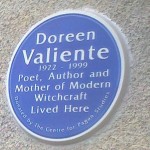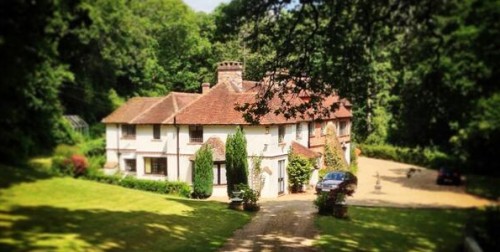On Friday, June 13 as the full moon rose, the man called “the father of modern Witchcraft,” Gerald Brosseau Gardner, was officially honored with an national Blue Heritage Plaque. Whether the calendar and celestial alignment were right or whether it was just coincidence, the time had certainly come for the legendary Gardner to join Doreen Valiente in English historical immortality.

[Photo Credit: Jane Thomson (Open Plaques donation) CC/ Wikimedia]
Nearly a year after Valiente’s ceremony and 130 years after his birth, Gardner has now become the second Witch to receive a blue heritage plaque. Funded wholly by donations to the Doreen Valiente Foundation and organized by the Centre for Pagan Studies (CPS), Gardner’s plaque was affixed to the home in which he lived in from 1938-1945. According to the CPS, “it was from this house he walked to his initiation into the New Forest Coven in 1939.”
John Belham-Payne, founder and director of the Centre for Pagan Studies (CPS), told the BBC that,”Gerald is one of those people who has been recognized nationally now because [his] name is included in the Oxford Dictionary of National Biography.” The inclusion of the plaque is a natural offshoot of that recognition. One signifier of this growing acceptance is the BBC’s expansive coverage of the plaque’s unveiling as well as a recent BBC radio interview with Belham-Payne.
The entire heritage event, from start to finish, has been a result of the cooperative efforts of the Centre for Pagan Studies (CPS), the Children of Artemis (COA) and the Doreen Valiente Foundation. On its fundraising page, the Foundation explains:
We are heading the campaign to have commemorative blue plaques placed where people who have shaped pagan history have lived or worked. These are landmark events [are] really wonderful in terms of promoting tolerance and raising awareness of how important the trailblazers of the past are, and also their relevance today, and how important it is to keep alive the work that they have done and to continue with it.
The Foundation managed the fundraising campaign that collected the needed funds it took to manufacture and install the blue heritage plaque. Donated funds also offset all associated costs of the daytime unveiling ceremony.

Mill House where Gardner was initiated [Photo Credit: Damh the Bard]
![Before the Unveiling [Photo Credit: Damh the Bard]](https://wildhunt.org/wp-content/uploads/2014/06/10366121_10152471922426070_6728929025827422349_n-500x375.jpg)
Before the Unveiling [Photo Credit: Damh the Bard]
At 4 p.m. the festivities moved to Highcliffe Castle. Tickets to the event cost £5 to cover the cost of facility rental. According to organizers, the celebratory evening event was completely sold-out.
Gardner’s biographer, Philip Heselton gave a reading and talk. In an interview with the BBC a few days prior, Heselton said:
[Gardner] wasn’t a religious pioneer. What he did was to publicize [Wicca] and write about it and he gradually became known through that and people made contact … He initiated quite a lot of people into the Wiccan culture. He felt it was important that it survived.
![[Photo Credit: Damh the Bard]](https://wildhunt.org/wp-content/uploads/2014/06/10445991_10152471922346070_3008786090723395777_n-e1402754963941-500x357.jpg)
[Photo Credit: Damh the Bard]
It was an amazing day. Thinking back to the early 1990s when some Christian groups fabricated the satanic Child Abuse scandal; when the News of the World thought it acceptable to vilify Pagans in their now thankfully defunct rag; and now 20 years later we stand before Gerald Gardner’s house with the Deputy Mayor unveiling a blue plaque for the Father of Modern Witchcraft. We have come such a long way. This was a great day, not just for British Wiccans, but for Pagans of all Paths all over the world. One day we will be the ancestors, and what we do today will shape Paganism for many years to come.
Robin Taylor, the Pagan Federation‘s treasurer, was also in attendance at the ceremony. In retrospect, he said:
The unveiling of a blue plaque to Gerald Gardner on the site of the house in Highcliffe where he lived was not only a very happy occasion for all present, but also significant in the growing acceptance of Paganism in England. Pagans of many paths have a connection with Gerald and an appreciation of his achievements, and this event provided an opportunity to celebrate his life.
So on that “amazing day,” Friday the 13th 2014 on a full moon, Gerald Brousseau Gardner, the “father of modern witchcraft,” was honored on his 130th birthday with the unveiling of a commemorative blue plaque marking his contributions to both Pagan and English heritage.
But one question remains. As prompted by the Centre for Pagan Studies own Logo, who is next?

[Correction 6-17-2014: This article was amended slightly to de-emphasize any suggested official involvement of the English Heritage organization. Although the plaques are listed on a community-based open plaque register linked to its site, the EH group was not involved with either the Valiente or Gardner Blue Plaques campaigns. These projects were solely the work of the Centre for Pagan Studies and associated organizations.]
The Wild Hunt is not responsible for links to external content.
To join a conversation on this post:
Visit our The Wild Hunt subreddit! Point your favorite browser to https://www.reddit.com/r/The_Wild_Hunt_News/, then click “JOIN”. Make sure to click the bell, too, to be notified of new articles posted to our subreddit.
This is really great!
Good article, but in truth it would be more accurate to write the one caption as “Mill House, where Gardner claimed to have been initiated.” He was always the only source for that story.
Who’s next? I’d suggest Dion Fortune. Though she was born in Wales, not England, she moved to England for college and apparently stayed (and died) there.
Hi Steward, this is a very good suggestion – we will put it on our list to be discussed
Pat Crowther
Hi Janette, Pat Crowther is still alive! there is a rule that a Blue Plaque can only be installed 20 years after passing.
Ah – I did not know that rule! OK – thinking cap on – who died 20 years or more ago?
Arnold Crowther? One of the homes of Edith Woodford-Grimes? Can there be a plaque at the Bricket Wood Cottage? (Even if it wasn’t strictly a residence?) Barbara Vickers? Thelma Capel?
The actual plaque with manufacture and installation can cost up to 4000 British pounds, this is depending on the location and the price the builders charge for the installation. this is why we are constantly asking for donations. If you can spare a couple of pounds towards the Pagan Heritage Plaque project please visit http://www.doreenvaliente.org/Doreen-Valiente-Donate-5.php#sthash.kVl2ON15.dpbs it is an ongoing project and we have much work to do!